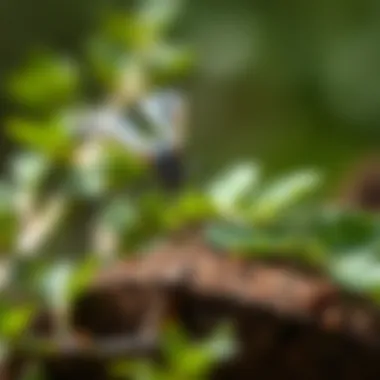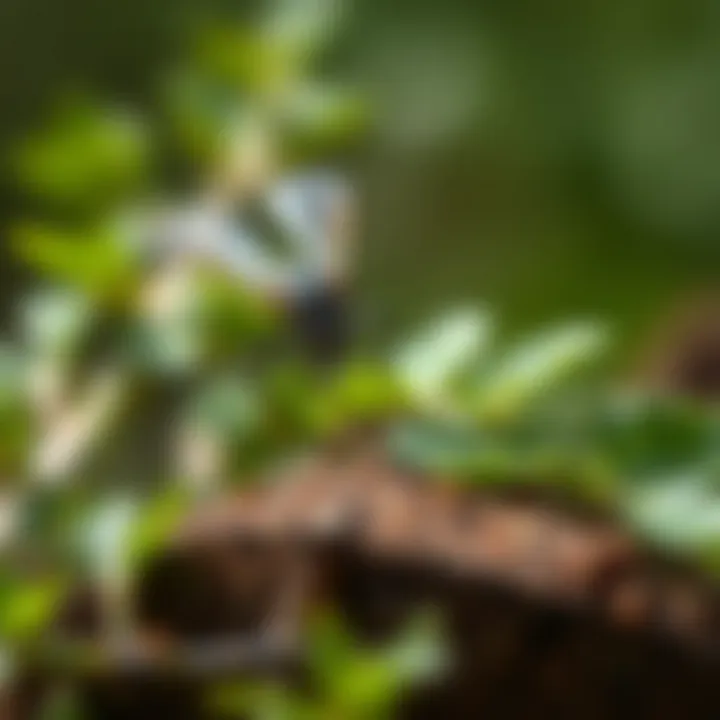Effective Pest Control Strategies in Kennesaw, GA


Intro
Kennesaw, Georgia, offers a picturesque setting with its lush landscapes and historic charm, but with that beauty comes a common hitch: pests. Understanding how to tackle these unwelcome visitors is essential for maintaining a healthy living environment. This article serves as a guide, shedding light on the ongoing battle against pests, while enhancing your knowledge on identification, prevention, and treatment strategies tailored to your needs. Whether you're a long-time resident or new to the area, being informed about the unique challenge pests pose is critical.
Pest Identification
One of the foundational steps in effective pest control is identifying the specific pests that may infiltrate your home. Kennesaw is not immune to several notorious pests, and recognizing them can make all the difference in response time and treatment efficacy.
Detailed descriptions of common pests
In Kennesaw, residents often encounter the following pests:
- Ants: Various species, including fire ants and carpenter ants, can be problematic. Fire ants tend to build mounds in open areas, while carpenter ants are notorious for burrowing into wooden structures.
- Termites: These small, wood-destroying insects can inflict major damage. The signs usually include mud tubes or sawdust around wooden fixtures.
- Roaches: The American cockroach and German cockroach are prevalent here, known for their resilience and ability to breed quickly.
- Rodents: Mice and rats are not just a nuisance; they can also carry diseases. Look for droppings, gnawed holes, or nests hidden in house corners.
Signs and symptoms of infestations
Identifying an infestation early can save you a truckload of trouble. Here are some signs to keep an eye out for:
- Unusual sounds at night, such as scurrying or gnawing noises.
- Leftover food or droppings in hidden areas.
- Visible trails or nests made from shredded materials.
"Early action can be the difference between a minor inconvenience and a major headache in pest control."
Prevention Strategies
Prevention is always better than cure, especially when it comes to pests. A few simple strategies can make your home less inviting for these intruders.
Home maintenance tips for pest prevention
- Seal cracks and crevices: Pests often find their way in through minute openings. Inspect areas around windows, doors, and utility pipes.
- Keep a tidy home: Regular cleaning doesn't just help with aesthetics; it eliminates food sources for pests. Pay close attention to kitchens and dining areas.
- Manage outdoor surroundings: Keep grass trimmed and remove debris where pests can hide.
Natural deterrents and barriers
Consider employing some natural methods to keep pests at bay:
- Essential oils such as peppermint or tea tree oil can deter ants and spiders.
- Diatomaceous earth can be sprinkled in areas prone to insect activity, creating a barrier that pests can't traverse.
Treatment Options
When prevention measures fall short, knowing your treatment options can be a game changer for homeowners in Kennesaw.
Overview of chemical vs. natural treatments
Many people weigh the benefits of chemical treatments versus more natural approaches:
- Chemical treatments often offer quicker results but may come with health risks and environmental concerns.
- Natural treatments can be safer for households with children and pets, though they may require more perseverance for success.
Step-by-step guides for DIY treatments
Here’s a straightforward method for dealing with common pests at home:
- Identify the pest and its entry points.
- Clean the area thoroughly to remove any food sources.
- Apply natural deterrents, like a vinegar solution, to act as a repellent.
- Set up traps to capture rodents or insects, placing them along walls or areas of frequent activity.
- Monitor regularly and make adjustments as needed.
For those who wish to dive deeper into pest control strategies, resources such as CDC and EPA offer additional guidance and support. With awareness and proactive measures, pest control can be effectively managed, ensuring your home remains an inviting and safe space.
Overview of Pest Control in Kennesaw, GA
Pest control in Kennesaw, Georgia, is not just a seasonal chore; it’s a significant part of maintaining a safe and healthy living environment. As residents of this vibrant community navigate the nuances of homeownership, understanding pest control becomes vital. The warm climate and rich landscapes of Kennesaw create an ideal breeding ground for pests, amplifying the need for proactive and reactive measures to manage infestations effectively. This section delves into the critical elements of pest control, emphasizing its importance to homeowners and the broader community.
When managing pests, homeowners are often faced with a series of considerations. One of the key factors is the type of pests present in the area. Kennesaw's vegetation attracts various insects and rodents, making it crucial to identify specific threats. For instance, local homeowners must be particularly wary of pest control methods that might harm beneficial insects or disrupt local ecosystems. Instead, tailored approaches, such as integrated pest management, are becoming increasingly popular to ensure effective control while preserving the environment.
Moreover, the benefits of localized pest management cannot be overstated. Residents stand to gain significantly from adopting strategies that are not only effective but also environmentally sound. Having a clear grasp of the history of pest issues in Kennesaw can complement this understanding. It helps to avoid repeating past mistakes and encourages the use of innovative prevention methods that work well for the area's unique characteristics.
"Pest control is a blend of art and science; knowing the right way to manage pests means understanding both the creatures and the habitat they thrive in."
Finally, this guide aims to offer homeowners insightful knowledge and practical solutions tailored to the specific challenges posed by pests in Kennesaw. By forging strong pest management strategies, homeowners can enjoy a more peaceful living environment while reducing damage risks to their homes. The power to safeguard one's environment lies in understanding the methods, significance, and implications that pest control brings to Kennesaw, Georgia.
Historical Context of Pest Issues
The history of pest issues in Kennesaw sheds light on the evolution of pest management practices in the area. Traditionally, pests like termites, roaches, and various rodents have troubled residents. These challenges are not new; they have been part and parcel of the Kennesaw living experience since its early days. As the town grew, so too did the types of pest challenges faced by homeowners, reflecting changes in land use, population density, and climate.
In decades past, the emphasis was often on chemical solutions, which although effective in the short term, sometimes resulted in harmful consequences for local ecosystems and human health. This historical reliance on heavy-duty pesticides has led to greater awareness and shifts towards more sustainable practices today. Understanding this backdrop puts current challenges into perspective, allowing residents to appreciate the advancements made over the years.
Importance of Localized Pest Management
Localized pest management is essential in Kennesaw for several reasons. First, it recognizes that not all pests are created equal; different species thrive in various microenvironments. Consequently, strategies that work in one part of the town may not be effective in another. For instance, suburban areas might face different ant species than those found in the more wooded regions.
Adopting localized practices means that pest control efforts consider specific environmental factors, pest behavior, and community needs. These targeted approaches lead to better outcomes, both in terms of efficacy and sustainability. They also allow homeowners to engage with pest control in a more informed way, fostering a sense of responsibility for their immediate environment.
Taking action that aligns with one's local ecosystem not only minimizes negative impacts but also promotes healthy biodiversity in Kennesaw. As pest challenges evolve, so must the responses of those who inhabit these beautiful spaces. Understanding these localized strategies can provide families with the edge they need to keep their homes safe from unwanted pests.
Common Pests in Kennesaw
Understanding the pests that are commonly found in Kennesaw, Georgia, is crucial for effective pest management. This section delves into various pests that threaten homes in the area. Homeowners need to be aware of these intruders to take proactive steps toward identification and management. The significance lies not just in dealing with current infestations but also in preventing future issues. Knowledge of local pests empowers homeowners and renters alike to safeguard their living spaces effectively.
Termites: A Region-Specific Threat
Termites are a significant concern for many in Kennesaw. Known for their wood-eating habits, these insects can cause devastating structural damage if left unchecked.
A few key factors to consider include:


- Local Climate: The warm, humid climate in Georgia creates an ideal environment for subterranean termites.
- Signs of Infestation: Look for discarded wings, mud tubes, or hollow-sounding wood.
- Preventative Measures: Regular inspections and treatment options can help thwart infestation.
Stay aware and address any signs quickly, as even a small colony can turn into a significant problem with alarming speed.
Rodents: Identification and Management
Rodents, particularly mice and rats, pose health risks and property damage. Recognizing their presence early is vital.
Some tips for identification include:
- Physical Signs: Droppings, gnaw marks, or nests.
- Behavioral Indicators: Nocturnal activity is typical, so listen for scratching sounds at night.
- Management Techniques: Sealing entry points, using traps, and maintaining cleanliness can make your home less inviting to these pests.
Engaging in suitable management practices clears up many potential rodent issues before they escalate.
Ants: Various Species and Their Risks
Ants can be more than just a nuisance; certain species found in Kennesaw can cause significant damage or health concerns.
Consider these aspects:
- Common Species: Fire ants can cause painful stings, while carpenter ants may damage wooden structures.
- Identifying Infestations: Look for ant trails, nests, or even individual ants wandering about in your living space.
- Risk Management: Use bait traps and follow proper sanitation practices to minimize attraction.
Taking the time to recognize the types of ants in your area can streamline control efforts.
Cockroaches: An Overview of Species in Kennesaw
Cockroaches are infamous for their resilience and ability to thrive in various environments. Kennesaw residents often encounter species such as the German cockroach and the American cockroach.
Key pointers:
- Identifying Species: Distinguishing between species helps tailor control methods effectively. The German species is smaller and prefers kitchens, while the American kind is larger and might be found in basements.
- Health Concerns: They can exacerbate allergies and asthma, making their presence a health hazard.
- Preventative and Management Strategies: Seal cracks, keep food stored properly, and consider professional pest control if infestations persist.
In brief, Kennesaw’s pest landscape presents a layered challenge. For homeowners, it's essential to envisage these pests as not just unwanted visitors but threats that demand prompt recognition and action. Armed with understanding and appropriate strategies, everyone can work to lessen the impact of pests on their homes.
Pest Identification Techniques
Identifying pests accurately is crucial in pest control. Without a clear understanding of what’s infesting a property, it’s like trying to solve a puzzle without all the pieces. Proper identification not only assists in choosing the correct treatment methods but also helps prevent future infestations. Misidentifying a pest can lead to ineffective treatment and wasted resources.
A meticulous pest identification process can lead to:
- Targeted Treatment: Different pests require different control methods. For instance, termites and ants might seem similar at a glance but need distinct approaches for effective management.
- Cost Efficiency: By identifying the pest correctly on the first attempt, homeowners can save time and resources. Otherwise, misdiagnosing can lead to unnecessary treatments that might not address the actual problem.
- Overview of Life Cycle: Understanding whether the pest is in its larval or adult stage can influence the type of treatment needed. Some infestations might warrant immediate action, while others may allow for a gradual approach.
Investing time in learning about the local pest issues—especially in Kennesaw—can be a boon for homeowners seeking to maintain a safe and healthy living environment.
Visual Identification Methods
Visual identification is the first line of defense in pest control. Homeowners should familiarize themselves with the characteristics of local pests to quickly recognize a potential problem. Here are a few pests commonly found in Kennesaw:
- Termites: They tend to be light brown or cream in color and are often identified by their swarming behavior during mating season. Look for small, mud-like tubes along foundation walls or wooden beams.
- Rodents: Mice and rats often leave clear signs. Mice are smaller with smaller droppings while rats have larger droppings and might also create burrows near food sources.
- Ants: Identification can be tricky because Kennesaw is home to various species. Carpenter ants, for example, may have a segmented body, while fire ants have more aggressive behavior and distinctive nests.
Visual cues are essential, but they should be combined with other methods for a comprehensive identification process.
Signs of Infestation
Recognizing signs of infestation can prevent a minor problem from spiraling out of control. Here are key indicators to watch for:
- Droppings: Pests like rodents leave droppings that are easily distinguishable. It’s one of the most significant signs. Finding droppings also points to high activity areas.
- Nesting Evidence: Look for materials like shredded paper or fabric, which mice and rats might use to build nests.
- Damage to Structures: Termites cause visible damage like hollowed out wood. Keep an eye on wooden structures; any soft areas should serve as a red flag.
- Unusual Sounds: Scratching or scurrying noises at dusk or dawn, similar to the sound of tiny feet, might indicate pest activity in walls or attics.
Effective pest identification relies on close observation and awareness. Don’t brush aside the small signs—those could be the tip-off to a larger issue that requires immediate attention.
By learning to identify the pests that are common in their vicinity, homeowners in Kennesaw can stay ahead of potential infestations, keeping their homes safe and pest-free.
The Impact of Pests on Homes
Pests can significantly affect not just the comfort and aesthetics of homes, but also their overall integrity and health. Understanding the impact of these often-overlooked nuisances is crucial for homeowners in Kennesaw, GA. Ignoring pest issues can lead to serious ramifications, both financially and physically. It's essential to focus on specific elements of pest damage, including structural integrity and health considerations, to appreciate the full scope of the problem.
Structural Damage from Termites
When it comes to pests that pose a palpable threat to the very foundations of a home, termites take the cake. These wood-eating insects feast on cellulose materials, including wood, paper, and even some types of insulation. The damage they cause can be extensive, leading to severe structural issues over time if left unchecked. Imagine coming home to discover that what appeared to be a solid wooden beam is entirely hollowed out.
Here are some key points to consider regarding termite damage:
- Hidden Threat: Termites often work behind walls or beneath floors, making early detection tough. Many homeowners only realize there’s a problem once significant damage has occurred.
- Costly Repairs: The financial burden of repairing termite damage can be staggering. Depending on the extent of the infestation, homeowners might face thousands of dollars in repair costs.
- Prevention Costs: Investing in regular inspections or chemical treatments can save a homeowner from the high costs of repairs later on. Prevention is certainly more effective than dealing with the aftermath of an infestation.
A study from the University of Georgia suggests that around 50% of homes in the Southeastern region will encounter termite issues at some point. In Kennesaw, it’s not just about treating the problem; it’s about taking proactive measures to shield your home.
Health Implications of Pest Infestations
While structural damage often steals the limelight, the health implications of pest infestations cannot be understated. Pests such as rodents and insects carry diseases that pose serious risks to occupants, especially children and the elderly.
Consider these health risks associated with common pests:
- Rodents: They can carry diseases like Hantavirus and Leptospirosis, which can be transmitted through their droppings, urine, and saliva. Simply being in an environment that has had a rodent infestation puts residents at risk.
- Cockroaches: These persistent insects are known to trigger asthma and allergies. Their waste products, including shed skin and feces, can lead to respiratory issues, making it vital to address these infestations promptly.
- Parasites: Bed bugs, while not necessarily disease carriers, can lead to significant discomfort and stress, with bites sometimes becoming infected due to excessive scratching.
"An ounce of prevention is worth a pound of cure" – this adage holds true about pest management. By taking proactive measures in your home, such as sealing entry points and maintaining cleanliness, one can mitigate the potential health risks from infestations.
In summary, pests can have severe impacts on homes in Kennesaw. From structural damage to health implications, understanding and addressing these issues becomes essential for maintaining a safe and healthy living environment.
Prevention Techniques for Homeowners
Effective pest control is much like preventive medicine; an ounce of prevention is worth a pound of cure. Applying the right prevention techniques can save homeowners in Kennesaw a world of trouble, both in terms of cost and stress. A proactive approach against pests can not only shield your home but also contribute to a healthier living environment.


Home Maintenance Strategies
Keeping a clean and well-maintained home is your first line of defense. Here are some specific maintenance strategies that are essential:
- Seal Entry Points: Check the exterior of your home for cracks or gaps, especially around windows and doors. A little caulking can go a long way. For example, using a good silicone caulk can block potential entryways for pests.
- Regular Inspections: Conducting routine inspections of your roof, attic, and basement will help catch problems before they escalate. Look out for droppings, nests, or other signs of pest activity.
- Proper Waste Management: Store garbage in sealed containers and ensure that your recycling is free of food residue. Keep exterior garbage bins covered and far from the house.
- Landscape Considerations: Trim back shrubs and trees from touching your house. Those branches can act as bridges for pests. Maintain a gap between mulch and your foundation, as it can retain moisture which attracts termites.
By integrating these home maintenance strategies into your routine, you put up barriers and make your home less appealing to unwanted visitors.
Environmental Management Practices
Beyond home maintenance, environmental management is crucial. This encompasses strategically managing your surroundings to deter pests effectively:
- Moisture Control: Pests like rodents thrive in damp environments. Fix leaking pipes and ensure your gutters are clean; standing water invites unwanted guests. Use dehumidifiers in areas that tend to get humid.
- Mulching Wisely: While mulching can enrich your soil and garden, over-mulching or using the wrong type can attract pests. Try using gravel or stones in certain areas to deter pests from nesting.
- Choosing Non-Toxic Plants: Consider using plants that repel pests naturally, such as marigolds or sunflowers. These plants not only beautify your space but also work as organic pest deterrents.
Implementing these environmental management practices offers dual benefits: they help in conserving the environment while keeping pest issues at bay.
"An ounce of prevention is worth a pound of cure."
Effective Treatment Options
Understanding effective treatment options for pest control is essential for maintaining a healthy and comfortable home environment in Kennesaw, Georgia. Choosing the right type of pest management can prevent infestations from taking root and becoming a bigger issue later on. The significance of this topic is not just in eliminating unwanted guests but also in safeguarding your home and family’s well-being. Homeowners must weigh various options, balancing efficacy against potential risks, costs, and environmental impacts.
The right pest control strategy will vary depending on the type of pest, level of infestation, and personal preferences. While some may opt for chemical treatments due to their immediate effect, others might prefer natural remedies that are less harmful to both the home and the environment. A combination of both methods can often provide a comprehensive solution.
Understanding these treatments not only helps in tackling current issues but also equips homeowners with the knowledge to prevent future infestations.
Chemical Solutions: Pros and Cons
Chemical solutions remain a popular choice in pest control, thanks to their swift action and effectiveness against various pests. However, understanding the advantages and disadvantages can help homeowners make informed decisions.
Pros of Chemical Solutions:
- Speedy Results: Many chemical treatments can eliminate pests in a short timeframe, offering immediate relief.
- Broad-Spectrum Effectiveness: Chemicals are effective against a wide range of pests, including those tough to control.
- Long-Lasting Residual Effects: Some chemicals provide prolonged protection, helping to prevent future infestations.
Cons of Chemical Solutions:
- Health Risks: There can be potential health risks for both humans and pets. Improper handling or exposure may lead to adverse reactions.
- Environmental Concerns: Chemicals can affect local ecosystems, harming beneficial insects and groundwater.
- Resistance: Over time, pests can develop resistance to certain chemicals, making them less effective.
It’s vital for homeowners to read labels carefully and follow guidelines to minimize risks associated with chemical pest control.
"Chemical controls should always be a last resort after exploring other less harmful options."
Natural Remedies and Their Efficacy
Natural remedies have gained traction among homeowners who seek sustainable and safer pest control methods. These solutions often utilize common household items or organic compounds to deter pests without harsh chemicals.
Benefits of Natural Remedies:
- Safety: They are generally safer for humans and pets, reducing concerns about toxicity.
- Environmental Friendliness: Many natural remedies are biodegradable and less harmful to the environment.
- Cost-Effectiveness: Some remedies can be made from readily available household items, including vinegar, baking soda, and essential oils.
Challenges of Natural Remedies:
- Effectiveness Variability: While some remedies work effectively against minor infestations, they may not be suitable for larger or more persistent problems.
- Shorter Duration: Natural treatments often require more frequent applications compared to chemical options.
- Preparation Time: DIY solutions may need preparation, requiring a bit more effort than simply spraying a chemical solution.
In Kennesaw, with its diverse ecosystem, utilizing a combination of both chemical and natural treatments may provide the best results. Homeowners can consider specific pest issues, environmental safety, and health implications when selecting their preferred treatment approach.
Professional Pest Control Services
In the face of persistent pest issues, professional pest control services have emerged as a necessity for homeowners in Kennesaw, GA. Not only do these services offer expertise in the pest control field, but they also provide peace of mind for those who may feel overwhelmed by unwanted intruders in their homes.
Pests like termites, rodents, and ants can wreak havoc on property, leading to costly damage and health risks. Thus, turning to professionals can be a wise investment. Their trained experts understand the behavior, life cycles, and effective treatment strategies specific to various pests, ensuring a targeted approach that DIY efforts often lack.
The benefits of engaging professional pest control services include:
- Expert Knowledge: Technicians are trained to identify and understand both obvious and subtle signs of pest presence.
- Personalized Solutions: Professionals assess the unique needs of each home and tailor strategies accordingly.
- Time-Efficiency: Professionals can address infestations more quickly than an amateur attempt, minimizing damage and disruption.
- Safety: They know how to handle potentially hazardous substances while taking safety precautions to safeguard children and pets.
When considering pest issues that seem insurmountable, the role of professional services cannot be understated.
When to Seek Professional Help
Knowing the right time to call in the pros can be a game changer. The following indicators signify that it might be time to seek professional pest control help:
- Persistent Infestations: If you notice the same pests returning despite efforts to eradicate them, it’s a strong indicator that professional intervention is needed.
- Health Risks: Rodents and cockroaches can spread disease. If you find any sign of these pests, it’s best to act fast.
- Structural Damage: Seeing signs of damage caused by termites or other wood-destroying organisms necessitates immediate professional evaluation.
- Lack of Knowledge: If you’re unsure how to identify or handle specific pests, a pest control service can provide guidance based on expertise.
In essence, if pest problems become more than a minor annoyance, reaching out for professional support ensures that you address the underlying issues effectively and safely.
Choosing a Pest Control Company in Kennesaw
Selecting the right pest control company is crucial. Kennesaw boasts several options, but not all services are created equal. Here are key considerations to keep in mind when making your choice:
- Reputation: Research local companies to see who your neighbors trust. Online reviews on platforms like Yelp or Google can offer insights into customer satisfaction levels.
- Certifications and Training: Make sure the company employs certified technicians who are knowledgeable about pest control and safety guidelines.
- Service Plans: Ask about what kinds of service packages they offer. Monthly, quarterly, or one-time treatments can be tailored to fit your needs.
- Guarantees: Look for companies that stand behind their work with guarantees, ensuring they’ll solve the problem or come back if needed.
- Transparency: A good company should be willing to explain their processes, the products being used, and any safety precautions they implement.
Regulatory Aspects of Pest Control
Understanding the regulatory landscape of pest control is crucial for homeowners and professionals alike in Kennesaw, Georgia. This section focuses on the local laws and regulations governing pest control practices, as well as the safety guidelines that ensure effective and secure treatment methods. Adhering to these regulations not only helps maintain the health of your home but also protects the environment and community at large.
Local Laws and Regulations
In Kennesaw, the laws surrounding pest control can be as intricate as a spider's web. Local authorities enforce these regulations to ensure safe and responsible practices in pest management. Homeowners need to be aware of specific requirements such as:


- Licensing Requirements: Pest control companies operating in Kennesaw must be licensed by the Georgia Department of Agriculture. This ensures that they adhere to state standards for pest management.
- Pesticide Regulations: There are strict regulations regarding the types and quantities of pesticides that can be used. Homeowners should be informed about which chemicals are appropriate for residential spaces to avoid harmful effects on health and the environment.
- Notification and Reporting: Many pest control treatments require notification to nearby residents. Understanding these obligations helps maintain community safety and transparency.
Engaging with these regulations not only safeguards your investment but also uplifts the community’s overall well-being.
Safety Guidelines for Treatment Practices
It’s not just the pests that need to be managed; ensuring safety during treatment is an essential part of pest control. Here are some safety guidelines that both homeowners and professionals should consider:
- Proper Storage of Chemicals: Pesticides should be stored in a cool, dry place away from direct sunlight and out of reach of children. This prevents accidental exposure and ensures the chemicals remain effective.
- Personal Protective Equipment (PPE): When applying pesticides, it’s essential to wear appropriate PPE, such as gloves, goggles, and masks, to protect against potential exposure.
- Follow Label Instructions: Always read and adhere to the label instructions on pesticide products. These instructions contain vital information regarding application methods, safety precautions, and emergency procedures.
Engaging with sensible treatment practices not only enhances the efficacy of pest control but also minimizes risks.
Ensuring safety in pest control practices is paramount - not just for your home but for the entire community.
Overall, regulatory aspects of pest control in Kennesaw lay down a foundational framework that encourages responsible management of pests. The guidelines and local laws discussed here promote safer, environmentally responsible approaches to pest management, highlighting the importance of compliance for every homeowner.
Debunking Common Myths about Pests
Understanding the truth behind pest behavior is crucial for homeowners in Kennesaw, GA. Misinformation about pests can lead to ineffective management strategies and unnecessary panic. By debunking common myths, this section will clarify misconceptions and foster more informed pest control decisions. This knowledge not only helps homeowners protect their properties, but it also ensures a more balanced approach to managing local ecosystems. Let's delve into two prevalent myths that often misguide homeowners.
Misconceptions about Termite Behavior
One prevalent myth is that termites only attack old or dilapidated homes. This is far from the truth. Termites are opportunistic pests, and they feast on cellulose-based materials regardless of a building's age or condition. They can thrive in a brand-new house just as easily as in a weathered one, making it essential for all homeowners to be vigilant. Here are key insights regarding termite behavior:
- Cold Weather Activity: A common belief is that termites become dormant during the cold months. While their activity does slow down, they do not fully vanish. Termites can survive winter conditions underground, ready to swarm and infest once temperatures rise.
- Chewing through Concrete: Another myth is that termites can’t penetrate concrete. While they can't chew through solid concrete, they are capable of entering through cracks and gaps, often lurking in wall voids or underground.
Understanding these behaviors helps ensure that homeowners adopt proactive measures for termite prevention, thus safeguarding their investments and preventing costly repairs.
The Truth about DIY Pest Control
Many homeowners believe they can easily manage pest problems on their own with readily available over-the-counter products. While DIY pest control may seem tempting, it often lacks the effectiveness that professional methods provide. Here are some points to consider:
- Superficial Solutions: Most DIY methods only address the symptoms rather than the root cause of pest problems. For instance, while spray treatments might kill visible insects, they do not eliminate nests or breeding grounds, allowing infestations to persist or reoccur.
- Safety Hazards: Many commercial pest control products contain potent chemicals that can harm pets or children if not used correctly. This risk is one aspect that makes professional expertise invaluable.
- Evolving Pest Resistance: Pests are notorious for developing resistance to common treatments. Relying solely on DIY methods without a comprehensive plan can lead to ineffective results over time.
"Addressing pest control without understanding the full context can be like treating a fever without checking for infection."
Long-term Pest Management Strategies
When it comes to pest control in Kennesaw, GA, the importance of long-term strategies can't be overstated. Short-term fixes might seem appealing, especially when you're facing an infestation, but addressing the root of the issue is crucial for lasting relief. Homeowners often find themselves trapped in a cycle of temporary solutions that only delay the inevitable. This section delves into the significance of committing to long-term pest management, offering insights that empower you to take control of your home environment.
One fundamental aspect of this approach is understanding that pests are not just a nuisance; they pose risks to both health and property. A long-term strategy involves ongoing evaluation and adaptation to the ever-evolving pest landscape. Think of it like a well-tended garden—if you only apply water sporadically, the plants will wither. Likewise, pest control demands consistent attention.
Adopting these methods brings a variety of benefits:
- Preventive Action: By implementing strategies before pests become a significant problem, you can save on costs associated with emergency treatments.
- Ecological Balance: A focus on long-term practices promotes harmony with the local ecosystem, reducing reliance on chemicals that could harm beneficial organisms.
- Sustained Effectiveness: Integrated approaches ensure your methods remain effective in combating pests over time, as resistance can develop when only one type of treatment is used frequently.
Ultimately, the path to a pest-free home lies in a well-planned, thoughtful management strategy that recognizes the interconnectedness of the environment.
Integrated Pest Management (IPM) Approaches
Integrated Pest Management, or IPM, serves as a cornerstone of effective long-term pest control. It encompasses a holistic view of managing pests by integrating various strategies and practices to monitor and reduce pest populations. Unlike traditional methods that rely heavily on pesticides, IPM employs a combination of biological, physical, and chemical tactics tailored to the unique conditions of Kennesaw.
Some common strategies in IPM include:
- Cultural Controls: Adjusting agricultural practices or landscaping techniques to make environments less hospitable for pests.
- Biological Controls: Utilizing natural predators or parasites to manage pest populations. For instance, introducing ladybugs can help keep aphids at bay.
- Mechanical Controls: Using traps or barriers to prevent pests from entering your home or garden. Simple devices such as screens or physical barriers can be surprisingly effective.
These methods not only provide effective pest control but also foster a more sustainable approach to managing the local pest ecosystem. For homeowners, embracing IPM can lead to significant peace of mind, knowing that you’re not just putting a band-aid on a bigger issue.
Monitoring and Evaluation Techniques
Monitoring and evaluation are integral to any long-term pest management strategy. Just as you wouldn’t ignore your car’s warning lights, you shouldn't overlook the signs of pest activity in your home. Effective monitoring allows homeowners to catch pest problems early before they spiral out of control.
There are several techniques to consider:
- Regular Inspections: Schedule routine inspections of key areas prone to pest activity, such as basements, attics, and kitchens. Keep an eye out for droppings, gnaw marks, or signs of nesting.
- Traps: Utilize traps to gauge pest presence. For example, sticky traps can provide visual evidence of pest movement and help identify the type of infestations you might be dealing with.
- Pest Threshold Levels: Establish acceptable limits for various pests. Knowing when to take action is crucial; not every sighting requires immediate treatment.
By dedicating effort to proper monitoring, you enable timely responses to pest issues and bolster the overall effectiveness of your management strategy. Staying ahead of the game means not only addressing existing concerns but also preventing future ones from taking root.
Embracing a long-term mindset in pest control not only safeguards your property but also protects your family and the environment.
These methods—Integrated Pest Management and diligent monitoring—are key components in creating a comprehensive, sustainable pest control plan tailored for Kennesaw homeowners. The proactive steps you take today can significantly influence your quality of life tomorrow.
Emerging Trends in Pest Control
As pest control evolves, it's crucial to stay abreast of the latest trends that shape this industry, especially in Kennesaw, Georgia. The need for effective pest management is becoming more paramount, particularly as urban development progresses and climate change alters pest behavior. This section examines the emerging trends in pest control that both homeowners and professionals need to consider for a sustainable and effective approach.
Technological Innovations in Pest Management
The confluence of technology and pest control has given birth to methodologies and tools that were unimaginable a few decades ago. One standout innovation is the use of smart devices equipped with sensors that can monitor pest activity in real-time. Picture this: a small device placed in your attic or basement alerts you via an app about increased rodent activity, allowing for swift action before a full-blown infestation occurs.
Moreover, drones are making waves too. These flying machines can survey large areas and help identify potential pest problems in hard-to-reach spots. Imagine assessing your entire backyard without ever needing to step foot out the door.
Furthermore, advancements such as thermal imaging cameras have opened doors for more precise identification of pest infestations, particularly termites, which can cause significant structural damage. By detecting heat patterns within wood, these cameras allow pest control experts to target their treatments more effectively.
The incorporation of artificial intelligence (AI) in pest control solutions enables the analysis of pest behavior and population dynamics, leading to better, more proactive management strategies. All these technologies collectively ensure that pest management can be more effective and less invasive.
Sustainable Practices in Pest Control
In recent years, there’s been a growing concern about the long-term effects of chemical pest control methods. This has led to a rising trend towards sustainable practices. Homeowners are increasingly seeking eco-friendly options to manage pests while minimizing environmental harm. One common method is using biological control, which involves introducing natural predators to manage pest populations. For instance, ladybugs are often released in gardens to control aphid populations, reducing the need for chemical sprays.
Integrated Pest Management (IPM) is another sustainable approach gaining traction in Kennesaw. IPM combines different strategies, such as habitat manipulation and the use of resistant plant varieties. This multifaceted technique not only addresses existing pests but also prevents future infestations through a more eco-conscious lens.
Utilizing organic materials and natural repellents is also on the rise. Ingredients like essential oils have been effective in repelling insects without the harsh side effects that come from synthetic chemicals.
"Adopting sustainable pest control practices not only protects our homes but also our environment, ensuring a healthier future for generations to come."
By paying attention to these emerging trends and implementing both technological innovations and sustainable practices, Kennesaw residents can stay ahead of pest problems while fostering a healthier ecosystem. Awareness of these trends ensures homeownership is not merely about managing pests but also about being a responsible steward of the environment.



